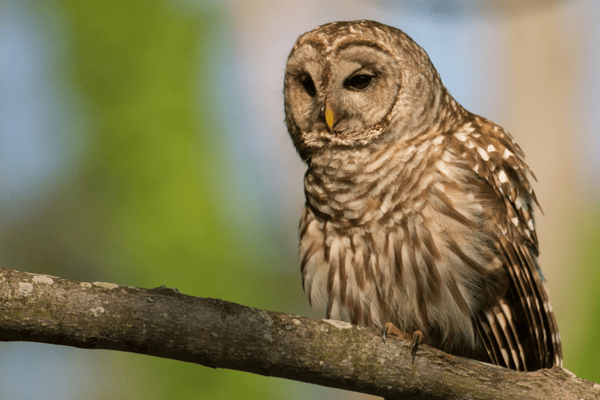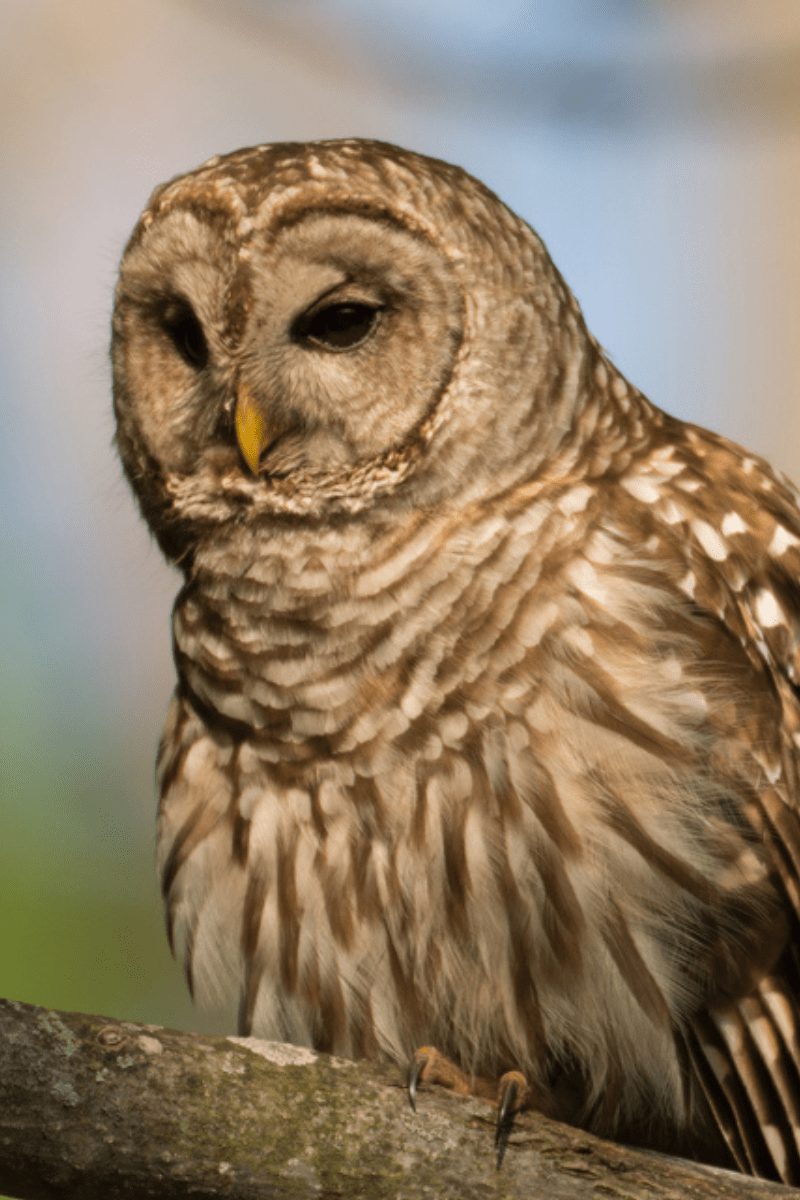Contents
The barred owl possesses the scientific name better known as Strix varia. This bird is considered a true owl and it’s a member of the Strigidae family of birds. Although the most common name for this bird is the barred owl, it has other names as well. Some of his other names are called hoot owl, striped owl, or the northern barred owl.
For the most part, this beautiful member of the true owl family can be found throughout parts of North America, including the eastern area in particular. But most interesting, the barred owl has expanded its territory, and now it can be found in forests on the West Coast as well.
Besides these interesting facts, other important information that I like to tell you about the barred owl includes:
- How to properly identify a barred owl
- The differences between females and males
- Fun facts regarding barred owls
- Feeding and dietary preferences
- Migratory, nesting, and behavioral habits
- And more invigorating topics
Discover the truth about the barred owl by reading below.
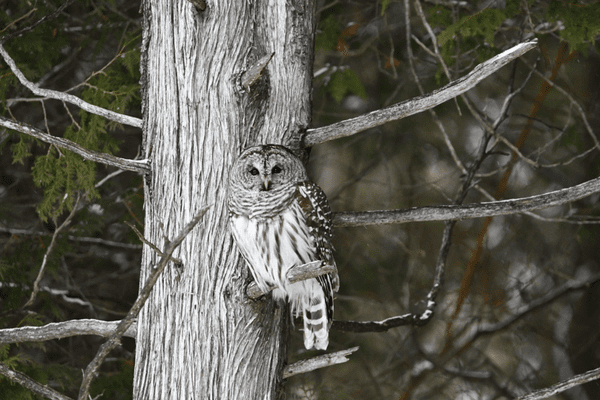
Barred owl facts
- Common Name: Barred Owl
- Scientific Name: Strix varia
- Scientific Family: Strigidae
- Life Span: 10+ years
- Size: 16 to 25 inches
- Wingspan: 38 to 49 inches
- Weight: 21.92 to 24.0 ounces
- Conservation status: Least Concern
Barred owl: how-to identify
Barred owls possess a very specific color pattern that makes them really stand out. They have lots of mottled brown within their feathers and the color white is often mixed in any kind of a striped design. Their eyes are nearly black. On their body, they have white feathers that are interspersed with vertical brown bars. In their upper breast area, horizontal brown bars make up the pattern. Their tales and wings are white and barred brown.
Differences Between Male & Female
Very common among owls is the female barred owl is a lot larger than the male of the species. In fact, females are roughly 1/3 bigger than their male counterparts. Their plumage remains the same whether male or female, so no differences in this regard.
Differences In Summer Plumage vs Winter Plumage
Barred owls do not appear to undergo seasonal color changes in plumage. Although, they do experience seasonal weight changes.
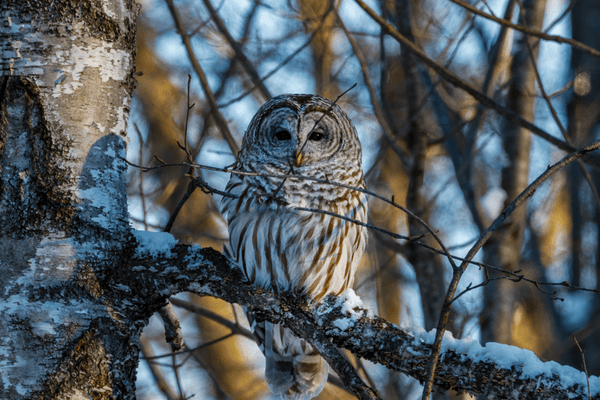
Where You’ll See Barred Owls
The National Audubon Society tells us that barred owls mostly like to spend time in wooded areas. You’ll find them regularly favoring areas with thick, dense woods that have very few scattered clearings. In fact, they like spending time in swampy wooded areas, wooded river bottoms, and woodlands.
For the most part, they tend to stick to mixed or deciduous woods when living in the southeast. But when they live in the north and northwest, it’s easier to find them nesting or perched in mature coniferous trees.
Barred owl bird migration
Barred owls maintain a permanent residence throughout many parts of the eastern region of the United States of America. You can find them in parts of Texas to Florida along the southeastern border. And their presence is all along the East Coast from Florida into New York into Vermont and New Hampshire and all away into the lower parts of Canada.
They also spent time near the Great Lakes in a limited capacity during the warmer seasons. And you’ll even find them on the West Coast in parts of California, Nevada, Oregon, Washington, Idaho, and Montana. But they only spend time in these areas during specific seasons, so you will not find them here all year-round.
Barred owl diet
The barred owl is an opportunistic hunter and nocturnal creature that typically hunts at night. Although, you can certainly find it hunting before dark at times as well as long as a good opportunity presents itself.
The typical prey of the barred owl includes meadow voles, deer mice, and shrews. Other mammals that this nocturnal creature will hunt include weasels, opossums, squirrels, make, rats, moles, bats, and young rabbits. It also hunts birds on occasion including pigeons, and Jay’s, blackbirds, quail, woodpeckers, and grouse. Lastly, it’s even known to eat fish, bugs, and reptiles including grasshoppers, Beatles, crickets, snakes, crayfish, scorpions, turtles, frogs, small fish, and lizards.
With small prey, the barred owl will devour it immediately on the spot. If they hunt and catch larger prey, they will take it with them to a feeding perch. Barred owls tear large prey apart prior to eating it.
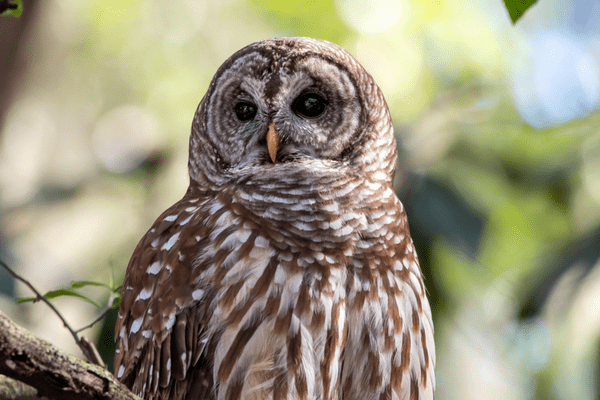
Barred owl nesting
- Clutch Size: 1-5 eggs
- # of Broods: 1 brood
- Incubation Period: 28-33 days
- Nestling period: 28-35 days
- Egg Description: White
During nesting, the male and female will undergo courtship rituals that include bowing and bobbing their heads, calling while perched close together, and raising their wings at one another. During courtship, male barred owls will sometimes feed the female that he is courting.
Typically, barred owls will create a nesting site in a large natural hollow inside of a tree. Or, they’ll take over the former nest of a squirrel, crow, or hawk. They occasionally but rarely nest on the ground. On the East Coast, barred owls typically take over nests no longer in use by red-shouldered hawks. And the red-shouldered hawk and the barred owl will share the nest using it during alternating years.
Barred owl behavior
The barred owl tends to remain active at night. But this doesn’t prevent it from calling or even hunting during the day.
This bird is relatively large, although it’s slightly smaller than the great-horned owl. Unlike the great horned owl though, this bird is much less aggressive. This often prevents the barred owl from spending time in the open woods, because it’s much tougher cousin will keep it out due to its lack of aggressiveness.
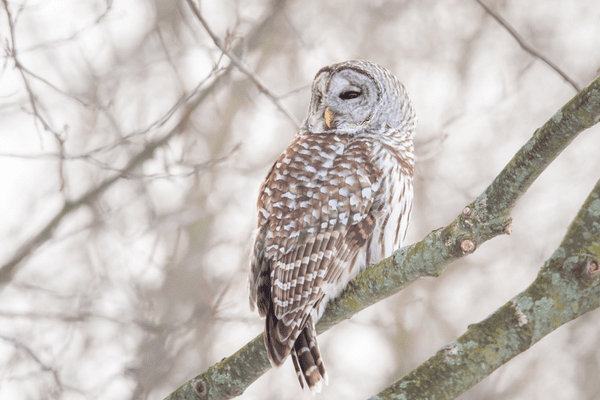
How-to attract barred owls
Like most owls, this creature isn’t very social and they blend in well with their surroundings, so you have a difficult time finding them in the wild. But if you look close enough, it’s definitely possible to see them in trees inside nooks and crannies that they call home.
To attract one of these birds, one of the first things to do is add a large birdbath in your backyard right near the trees. These owls love having a water source available to drink and bathe out.
These owls also have no problem taking over a nesting box, so feel free to put one in your backyard. It’s best to put it 20 to 30 feet off the ground in an area of land hardwood that’s mature. And even better, you should keep the birdbath within 200 feet of the nesting box to make it easy for meeting owls to quickly access this readily available source of water.
Other tips include:
- Keep backyard lights at a minimum because they scare barred owls away
- Keep pets inside – especially large dogs or other animals that might scare the owls away
- Grow big trees – this tip can obviously take years to come to fruition, but owls love nesting in large trees
Barred owl threats
As of now, these owls maintain a conservation status called Least Concern. This is a great sign for them because it means their population exists in large supplies. Although most recently these creatures are losing parts of their swap habitat in the South, their population is suddenly declining in these areas. More recently, these birds are beginning to range further to the northwest, and they’re competing with spotted owls for territory, food, and nesting spaces.
Barred owl fun & interesting facts
- Barred owls like to nest in hollow trees, but this isn’t their only nesting option. They will also claim abandoned nests from other animals including red-tailed hawks and squirrels.
- After establishing a nest, the barred owl becomes extremely territorial. They aren’t the most aggressive creature, but when rearing chicks, they will strike, hoot loudly, or attack using their talons most aggressively.
- The call of the barred owl is really interesting. It actually sounds like it’s speaking English. If you’re ever walking through the woods and hear the words “who cooks for you” over and over, you’re likely hearing the distinctive call of the barred owl.
- Barred owls choose mature forests as their preferred territories. These forests are filled with lots of tree cavities and abundant numbers of prey that they can listen for, scan for, and hunt for easy meals.
- For the most part, barred owls remain largely sedentary. Although, within the last century, they’ve begun expanding their range gradually. They have started moving to the Pacific Northwest of the United States and the Western region of Canada. Their much smaller cousin, the spotted owl, is facing extinction so their expansion is a problem for this endangered species.
- When barred owl hatchlings finally leave the nest, they typically tend to do so within 4-6 weeks of being born. They don’t go very far from mom and dad at this stage, but they are good climbers so they’ll climb trees, and roam around before they finally begin flying within 10-12 weeks of being born.
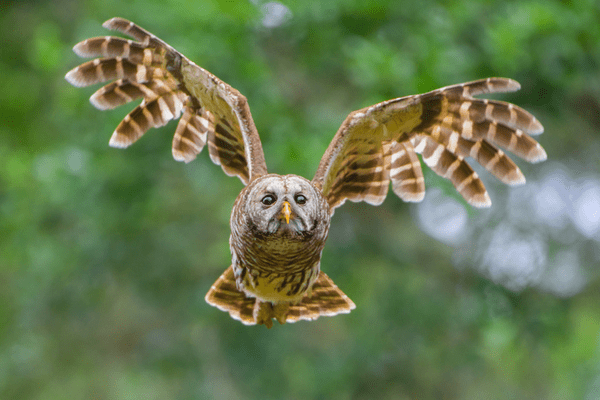
- Flammulated Owl
- Snowy Owl
- Boreal Owl
- Northern Saw-Whet Owl
- Northern Pygmy-Owl
- Spotted Owl
- Western Screech-Owl
- Long-Eared Owl
- Barred Owl
- Burrowing Owl
- Eastern Screech-Owl
- Short-Eared Owl
- Great Gray Owl
- Northern Hawk Owl
- Elf Owl

